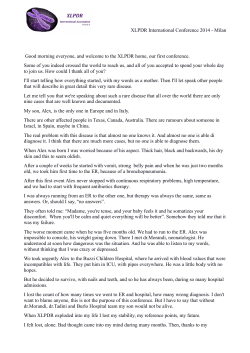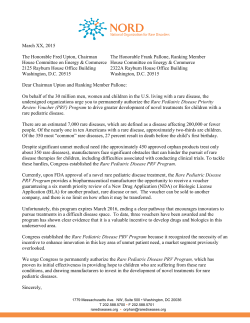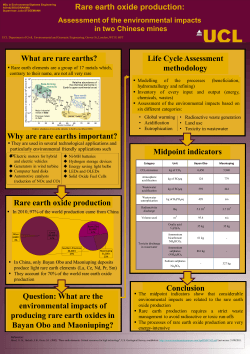
Read the article here - National Organization for Rare Disorders
PRODUCT DEVELOPMENT EMERGING COMPANIES REGULATION POLITICS, POLICY & LAW FINANCE PRODUCT DEVELOPMENT CHARTING RARE STARS BY EMILY CUKIER-MEISNER, SENIOR WRITER A databank constructed by the National Organization for Rare Disorders and the VHL Alliance could serve as a model for how patient organizations can generate natural history data to help speed development and FDA review of new treatments. The Cancer in Our Genes International Patient (CGIP) Databank was formally unveiled in May and discussed at NORD’s Rare Diseases and Orphan Products Breakthrough Summit held Oct. 21-22. CGIP is the first public launch from a NORD platform designed to help patient organizations manage their own registries as a vehicle for natural history studies and other research. NORD developed the platform because it saw a need for patient registries that are extensive and sophisticated enough for longitudinal studies of diseases that are not well understood, but also inexpensive and user-friendly so small patient communities can use them. VHLA’s goals for the registry are twofold: helping patients share data and connect with researchers, and helping patients and researchers better understand the disease’s natural history and variables involved in disease progression. Pamela Gavin, COO at NORD, said the platform’s focus on natural history helps patient organizations increase their role in researching and developing treatments. “From a functional perspective, it takes a simple contact registry and gives it more dimensions. It enables patients and patient organizations to contribute and participate in the drug approval process,” she said. At the summit, both FDA Commissioner Margaret Hamburg and Director of the Center for Drug Evaluation and Research Janet Woodcock hailed the CGIP Databank as a tool that can improve the agency’s ability to review treatments for rare diseases. “Having such a resource can yield vital information about biomarkers, demographic, genetic and environmental factors that correlate with the disease, as well as helping to identify patient subpopulations with different characteristics and effects,” Hamburg said at the meeting. In an Oct. 23 post on the FDAVoice blog, Woodcock wrote, “Knowledge of natural history is essential for developing more efficient clinical trial designs. It also could help reduce the length and cost of drug development and, possibly, contribute towards greater predictability of clinical development programs.” Anne Pariser, a medical officer in FDA’s Office of New Drugs at CDER, told BioCentury that FDA hopes other groups will explore similar methods of studying natural history. “NORD’s natural history study platform is flexible and can accommodate many rare disease natural history studies, and can be customized for different rare diseases,” she said. 5 WEEK OF NOVEMBER 10, 2014 “IT TAKES A SIMPLE CONTACT REGISTRY AND GIVES IT MORE DIMENSIONS. IT ENABLES PATIENTS AND PATIENT ORGANIZATIONS TO CONTRIBUTE AND PARTICIPATE IN THE DRUG APPROVAL PROCESS.” PAMELA GAVIN, NORD “Given the many unmet medical needs for rare diseases and the value that natural history studies can provide for furthering research, patient care and drug development, we encourage rare disease groups to explore initiating and conducting natural history studies through NORD or other available venues,” she added. A RARE PROBLEM von Hippel-Lindau disease is a textbook example of a rare disease where lack of understanding presents challenges in both treating the condition and developing new treatments. VHL is an autosomal dominant disorder caused by inactivating mutations of the vHL protein. It occurs in roughly one in 35,000 people worldwide. The protein is a tumor suppressor responsible for targeting hypoxiainducible factor 1 alpha (HIF1A; HIF1-alpha) and endothelial PAS domain protein 1 (HIF2A; EPAS1) to the proteasome for degradation. Elevated HIF levels lead to an angiogenic response that predisposes patients to developing benign or malignant tumors at multiple sites, such as the eyes, cerebellum, brainstem, spine, pancreas, adrenal glands and kidneys. Disease presentation can vary even between members of the same family. Eric Jonasch, associate professor in the Department of Genitourinary Medical Oncology at the University of Texas MD Anderson Cancer Center, said a lack of knowledge about VHL’s natural history affects all stages of drug development, from the ability to write research grants to supporting regulatory approval. He said understanding the disease is challenging because despite the common genetic defect, it’s not known how specific mutations in the vHL protein correlate with phenotypes, or the roles that other proteins play. Jonasch, who is also head of the Clinical Advisory Council and Research Council at VHLA, said the condition is managed by surgical removal of malignant lesions or nonmalignant lesions that are troublesome, such as those that occur in the eyes or CNS. BIOCENTURY TOC PRODUCT DEVELOPMENT No treatments are approved for VHL, and Jonasch wasn’t aware of any companies developing them. He said most trials are investigator-initiated studies of products developed for kidney cancer. Jonasch said renal cell carcinoma (RCC) often is driven by mutations in the vHL protein, and that kidney cancers are similar whether arising from sporadic or hereditary conditions. He said while endpoints like lesion regression are appropriate to measure in clinical trials, lack of knowledge about when and how lesions develop hinders interpretation of study results, as well as physicians’ ability to recommend treatments. “I treat patients, and if they have stability, I don’t know if that stability is because of me or despite me,” he said. “HAVING SUCH A RESOURCE CAN YIELD VITAL INFORMATION ABOUT BIOMARKERS, DEMOGRAPHIC, GENETIC AND ENVIRONMENTAL FACTORS THAT CORRELATE WITH THE DISEASE, AS WELL AS HELPING TO IDENTIFY PATIENT SUBPOPULATIONS.” MARGARET HAMBURG, FDA UNKNOWN UNKNOWNS CGIP was designed to collect data from as many patients as possible and track enough variables to spur researcher interest and reveal correlations that are entirely unknown or only suspected from anecdotal data. The databank will include information on demographics, medical history, genetics, nutrition and exercise, and physical and emotional health. CGIP includes patients diagnosed with conditions related to VHL, such as Birt-Hogg-Dube syndrome, succinate dehydrogenase complex subunit B (SDHB) genetic cancer syndromes, and hereditary leiomyomatosis and renal cell cancer (HLRCC; also known as Reed’s syndrome), an autosomal dominant disorder that predisposes development of tumors of the skin, uterus and kidney. Vincent Tsugranes, director of information technology at NORD, said 361 people are providing data to the registry so far. Patients are the primary data source and provide input by completing interactive online questionnaires and uploading medical information. Gavin said the databank includes over 1,200 questions. However, each patient is unlikely to have to answer that many, as tumors can manifest in different ways and many questions may not apply. EMERGING COMPANIES REGULATION POLITICS, POLICY & LAW FINANCE “The broad-based questionnaire allows us to capture things we don’t know we should be asking, which allows us to gain more insight into the overall effect that this disease has on people,” Jonasch said. Gavin said the project has already yielded at least one unexpected finding: VHL patients have a 40% increased risk of oral health problems. Jonasch hopes CGIP will eventually yield insights into disease biology that could suggest targets for treatments. “As we start layering more information in there, it may allow us to move forward into elucidating the mechanisms,” he said. VHLA Executive Director Ilene Sussman said only anonymous patient data from CGIP are shared outside of the VHLA, and that researchers interested in using CGIP can submit study proposals for review and approval by a VHLA committee. BROADER REACH In addition to working directly with patients, VHLA and NORD courted feedback from stakeholders at NIH and FDA to ensure the tool is broadly applicable. VHLA is responsible for the questionnaire content, data curation, analysis and patient management. Sussman said FDA provided feedback on the VHLA’s database design and the content of the questionnaires. NORD is responsible for software development and data storage. Gavin said NORD’s platform was developed to let groups collect large amounts of data longitudinally, and FDA requested that the platform be constructed to facilitate natural history studies, which could help mitigate some of the risks of trying to get rare disease products approved. Gavin added that the platform incorporated elements developed by NIH’s Office of Rare Diseases Research to help standardize data collection across diseases. Tsugranes said both FDA and NIH gave advice on research protocols to be used with CGIP, and that NORD will continue to partner with them and with patient organizations to validate research performed on its platform. Tsugranes said the platform contains some tools tailored toward the needs of smaller patient organizations, like ease of administration and automated tools for patient follow-up. Gavin said NORD is working with several other organizations on registries that can support natural disease studies. She said NORD hopes to eventually incorporate electronic health records in the platform, but will first need to resolve challenges related to lack of standardization and getting patient consent. COMPANIES AND INSTITUTIONS MENTIONED National Institutes of Health (NIH), Bethesda, Md. National Organization for Rare Disorders (NORD), Danbury, Conn. University of Texas MD Anderson Cancer Center, Houston, Texas U.S. Food and Drug Administration (FDA), Silver Spring, Md. VHL Alliance (VHLA), Boston, Mass. REFERENCES Woodcock, J. “The more we know about rare diseases, the more likely we are to find safe and effective treatments.” FDAVoice (Oct. 23, 2014) 6 WEEK OF NOVEMBER 10, 2014 BIOCENTURY TOC
© Copyright 2025










